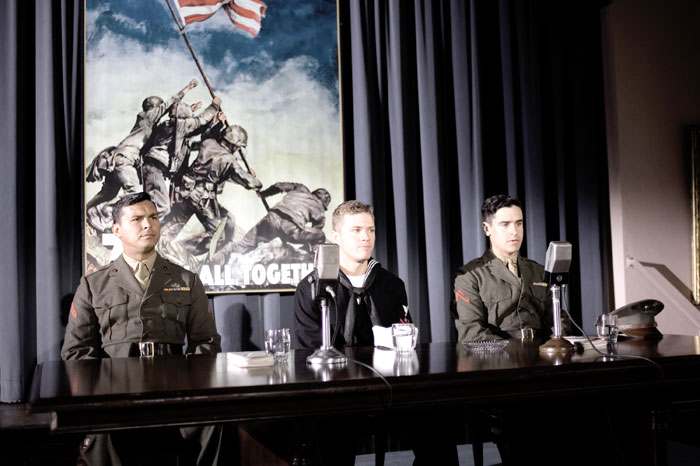Flags of Our Fathers

During the height of the battle for Iwo Jima in 1945, not one but two flags were raised over the battleground of Mount Surabachi. Few know about the largely unheralded first flag raising but the second one spawn a photograph that might well be the most famous in the entire world. Clint Eastwood tells the story of this photo and the impact it had on the men who raised the stars and stripes in “Flags of Our Fathers.”
Laura has not finished her review of this film.
Laura's Review: NYR
NYR
Robin's Review: B-
Based on the book by James Bradley and Ron Powers, Flags of Our Fathers: Heroes of Iwo Jima, Eastwood’s much anticipated work jumps through time as Bradley discovers that his father was one of the six men captured in the most printed photo ever. Before his death, John Bradley never talked about the war or his place in history and his son had to piece together the events of that day and its aftermath. The result is an uneven film that leaps, sometimes awkwardly, from the days prior to the landing on Iwo, the invasion and its carnage, the flag raising, the morale boosting bond drive by the three survivors, the impact of “heroism” on Ira Hayes (Adam Beach) and later day talking head interviews with survivors of the battle. There is a lot going on in “Flags of Our Fathers,” maybe too much for a film that is just over two hours long. The frequent jumps in time and place often take you out of the film. Just as you get hooked on the well done battle scenes, the story pulls you into the (well-staged) war bond drive, cocktail parties celebrating John Bradley (Ryan Phillippe), Ira Hayes and Rene Gagnon (Jesse Bradford) as heroes and the controversy over the true identities of the flag raisers. (One of the men credited in the photo, Hank Hansen (Paul Walker), was not there that day. Instead, marine Harlon Block (Benjamin Walker) was really the sixth man, but only identified as such much later.) Flags…” has a huge cast, which is one of the film’s weak points. With so many players, from grunts to generals and, even, President Harry Truman (David Patrick Kelly), there are too many faces and short shrift is given to nearly all of the characters. Focus is placed on the three survivors but it is Ira Hayes’s tragic story that gets the most attention from the screenplay by William Broyles Jr. and Paul Haggis. Ira’s sad story could have been a movie unto itself – it was already made in 1961 with Tony Curtis portraying the Pima Indian turned marine in “The Outsider” – so Eastwood’s take on his story feels rushed and not fully realized. Ryan Phillippe does his best to give dimension to his corpsman Bradley and does a solid job showing the bravery these medicos displayed every day during the battle. Jesse Bradford, as Gagnon, is given the least attention of the three. As one would expect from filmmaker Eastwood, detail is paramount in this production. The battlefield footage will be compared with “Saving Private Ryan,” which set the bar high for the realism of mortal combat, but this is to be expected. Uniforms, weapons, vehicles, ships and all look and feel like the real thing, making the production one of the best things about Flags of Our Fathers.” The war bond drive that the survivors must endure is also given the necessary attention. Techs are solid. Flags…” comes close, though nearly close enough, to recreating James Bradley’s memoir about his dad and the other survivors of the historic event. The frequent, uneven jumps in time make it seem rushed into release, possibly to garner attention for end of year award consideration. I don’t see this happening except for some technical aspects of the production. I’m hoping that Clint’s next film - “Letters from Iwo Jima,” telling of the battle from the Japanese viewpoint, shot in tandem with “Flags of Our Fathers” – will have the resonance that the current film lack.

